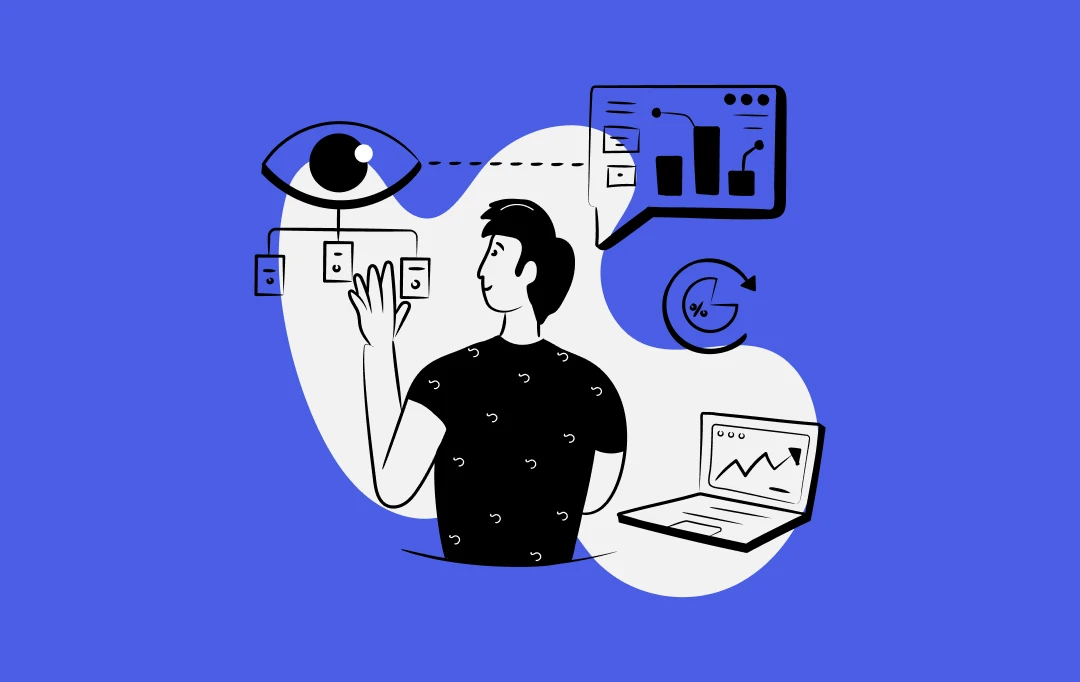- Why Computer Vision is Essential for Modern Workflow Automation
- Implementing Computer Vision Across Businesses: 10 Significant Applications
- Monitoring Road Conditions
- Natural Language Processing
- Mask Detection
- Monitoring Animals
- Crop Monitoring
- Harvesting Automation
- Analyzing Traffic Flow
- Tracking Customers
- Cancer Detection
- Predictive Maintenance
- Benefits of Computer Vision in Business
- Cost Savings
- Increased Efficiency
- Accessibility
- Quality Control
- Robust Safety
- Automation
- Multiple Uses
- Non-stop Working
- Emerging Computer Vision Trends to Look Up to
- Edge Computing
- Augmented Reality
- Generative AI
- Autonomous Vehicle
- Computer Vision in Healthcare
- Navigating Challenges: Tackling Computer Vision Drawbacks for Businesses
- Employing Computer Vision With Appinventiv’s Expert Team to Empower Businesses
- FAQs
Computer vision is a branch of artificial intelligence that helps computers read images and videos and then extract data to use in various applications. The usage of computer vision in business can be attributed to several factors, such as gaining a competitive edge, streamlining operational workflow, and enhancing customer experiences.
The field of computer vision in AI is constantly evolving with advancements in technology and machine learning. As a result, businesses are gradually adjusting to the diverse applications of computer vision to boost output and preserve their reputation.
A Grand View Research analysis projects that the size of the worldwide computer vision industry will increase at a compound annual growth rate (CAGR) of 19.6% from 2023 to 2030. Considering the provided statistics, it is safe to assert that computer vision technology will only become more powerful in the future.
This blog will talk about how you can implement computer vision for business, its best use cases, the benefits of computer vision in business, future trends to look up to, and the challenges of machine vision in businesses.
Why Computer Vision is Essential for Modern Workflow Automation
Spanning multiple decades, the history of computer vision technology began in the latter part of the 1960s. With multiple iterations over the years, gradually, researchers found that the use of computer vision in facial recognition could boost the process significantly. With the introduction of big data in the 2000s, real-time face detection technologies significantly improved, changing the course of computer vision history. Today, the global facial recognition market is expected to reach $19.3 billion by 2032, as per a report by Market.us.
As we move through the 2020s, the advancements in IoT, robots and AI are changing computer vision. The ability of machines to perceive and comprehend the world similarly to that of humans is gradually developing and empowering hundreds of other domains. Data Bridge Market Research predicts the worldwide computer vision market size to reach $26.65 billion by 2031.
Provided data instances highlight why companies should learn about the uses of computer vision and integrate them into their workflow automation. You can leverage the applications of computer vision in business in diverse ways. From daily tasks like image recognition and document translation to operational activities including predictive maintenance to forecast inventory and inventory management, computer vision’s potential is limitless!
Implementing Computer Vision Across Businesses: 10 Significant Applications
To understand the work of computer vision in business, we have to go through some of its use cases. Let’s dive right now into the wide range of applications of computer vision in business.
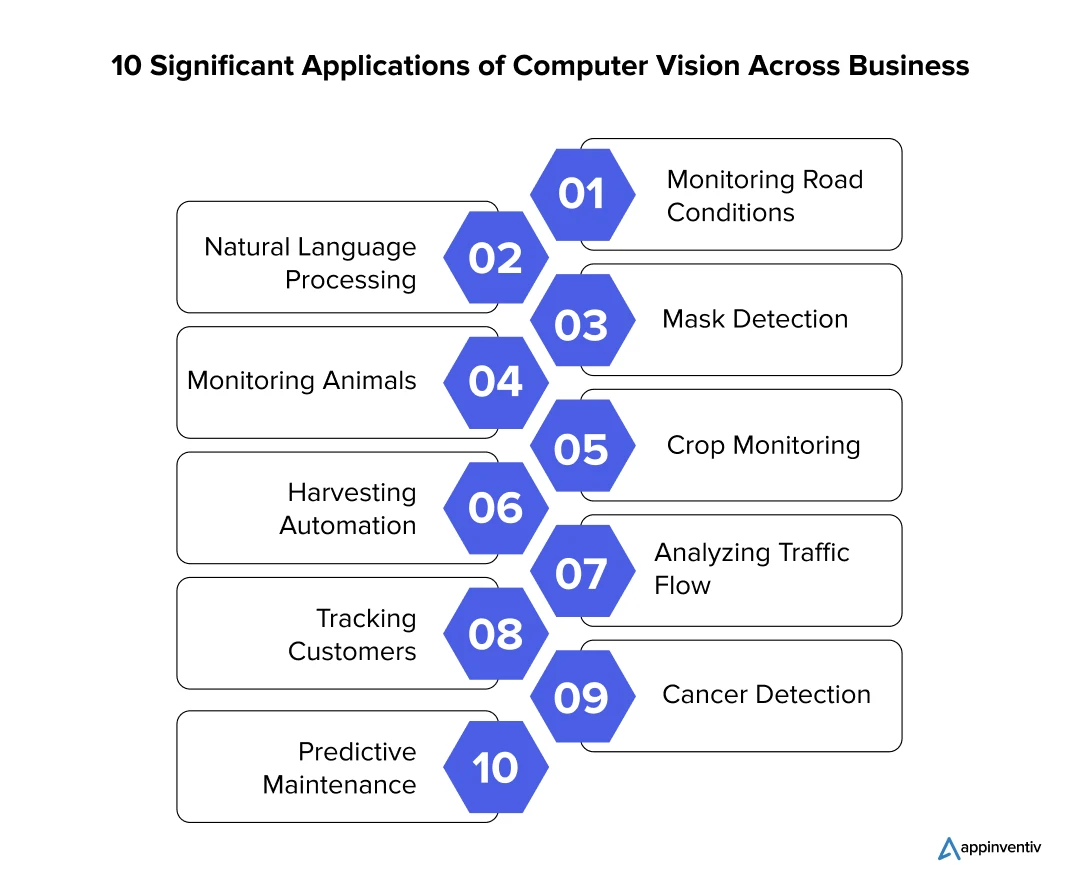
Monitoring Road Conditions
Computer vision-based fault detection and condition evaluation have been created to monitor civil infrastructure made of concrete and asphalt. Pavement distress assessments are often carried out by foot-on-the-ground surveys and/or advanced data collection vehicles.
Information from pavement condition assessments helps managers of pavement networks make more consistent and economical judgments. Here, deep learning techniques are leveraged to create automated methods of road distress identification.
Example:
To automate labor-intensive road pavement problem inventory and give transportation organizations better data for decision-making, RoadAI came into existence, leveraging the capabilities of computer vision in a business. This software enables easy detection of road distress to fix and improve the overall condition and longevity of roads.
Natural Language Processing
Artificial Intelligence is a potent tool for natural language processing (NLP), whereas computer vision uses optical character recognition to translate text from images, photos, or pictures. The amalgamation of natural language processing, computer vision, and speech detection can significantly enhance the caliber of client interactions across various domains.
Example:
An illustration of this use of technology is the Google Translate app, whose system can recognize patterns in visual data and generate words from this input upon a user’s request. The user needs to take a photo or download one for quick translation from a foreign language.
The translation process itself follows the computer vision algorithms’ iterations. It may be done both online and offline, which makes it possible to communicate more effectively and accurately in a variety of situations, particularly when a user is pressed for time.
[Also Read: How Much Does It Cost to Build a Text-to-Video Generator like OpenAI’s Sora?]
Mask Detection
Another use case of computer vision for business lies in masked face detection. This was extremely helpful during the Covid-19 pandemic as masks were extensively used by people to protect themselves from the virus. Computer vision systems supported the nations in using masks as a control measure to stop the coronavirus sickness from spreading.
Example:
Private companies like Uber developed computer vision technologies like facial detection to determine whether or not passengers are wearing masks for their smartphone apps. Public transportation was safer during the coronavirus pandemic, thanks to initiatives like these.
Monitoring Animals
Animal behavior can be remotely monitored in real-time with the use of computer vision systems. It is one of the main components of smart farming. The goal of smart vision systems is to study animal behavior to improve animal welfare and productivity. In this case, computer vision can help with tracking childbirth, diagnosing illness or abnormal behavior, and counting animals, which further impacts the yields and industry profits.
Example:
Cincinnati Zoo is in talks of implementing new technology powered by computer vision to create a system that helps check animal health within their enclosure. The system is specially designed to track the health of each animal through non-invasive methods, creating informative heatmaps to help experts assess health changes and associated concerns with environmental changes.
Crop Monitoring
Computer vision has a lot of applications in the agricultural sector, starting with crop monitoring and disease detection. Crop growth monitoring has historically been unreliable and based mostly on human opinion. The stability of food security is dependent on the yield and quality of key crops like wheat and rice.
We can non-destructively observe how plants grow and respond to nutrient requirements, thanks to computer vision applications in businesses. Compared to manual operations, computer vision technology used for real-time crop monitoring may identify small changes in crops caused by malnutrition considerably earlier. This can offer a trustworthy and accurate foundation for appropriate management.
Example:
Aravind Krishnaswamy Rangarajan and Raja Purushottam of Tamil Nadu in India used computer vision to analyze the health status of a plant. They used automated devices to obtain images of the plant and found a segmentation accuracy of 89%. Some of the techniques they applied are the contour grow technique and particle-wave algorithm.
Harvesting Automation
Traditional agriculture relies heavily on human harvesting for its mechanical activities, which leads to high costs and low efficiency. On the other hand, sophisticated, intelligent agricultural harvesting devices, like picking robots and harvesting machinery, have recently surfaced in agricultural production as a result of the ongoing application of machine vision in businesses.
Since Precedence Research predicts the market size of artificial intelligence in agriculture to grow annually at a rate of 23.3% from 2023 to 2032, this represents a new development in the automatic harvesting of crops. Ensuring product quality during the harvesting process is the primary goal of harvesting operations to enhance market value.
Example:
Using a non-destructive technique, Dóra Faragó assessed the morphological and physiological characteristics of plants cultivated in vitro. Using MATLAB, the photos were thoroughly examined, and key variables, like plant size, convex ratio, and chlorophyll concentration, were computed.
This approach emerged to be comparatively easy to use, inexpensive, and highly versatile. Further research was done by M.P. Rico-Fernández. They used several machine learning algorithms to study the effects of botanical markers and they noted changes in crop types, leaf color, and other factors.
Analyzing Traffic Flow
Traffic flow analysis is one of the important use cases of computer vision in businesses. In-depth research has been done on traffic flow analysis for ITS (intelligent transportation systems). This employs both non-invasive techniques like cameras and intrusive techniques like under-pavement coils and tags.
The development of computer vision in AI has made it possible to apply video analytics to widely used traffic cameras, which has enormous potential to impact ITS and smart cities. Computer vision techniques can further be used to measure some of the variables needed by traffic engineers to observe the flow of traffic.
Example:
The students of the Philippines University created a web-based system, leveraging the prowess of computer vision to detect real-time traffic situations in the city of Butuan. This variant of traffic visual analysis system used light-weight devices at the road’s intersection to visualize traffic situations in real-time. This visualization provided detailed, real-time access to the happenings occurring on the particular road they’re using to help make optimized decisions.
[Also Read: How AI is Transforming Traditional Surveillance Systems]
Tracking Customers
To monitor customer foot traffic in retail businesses, computer vision in machine learning algorithms can process the video streams in real-time. Reusing the video stream from low-cost security surveillance cameras is possible with camera-based techniques.
Learn 10 Game-Changing Ways to Deploy Computer Vision in Retail
The algorithms identify people anonymously to examine their time spent in various regions, waiting periods, and queueing times. It can also evaluate the quality of the services, further strengthening customer service practices.
Example:
Amazon’s leading, one-of-a-kind endeavor, Amazon Go, works on a similar computer vision application. It leveraged the innovative computer vision solution to create a unique ‘Just Walk Out’ system, which enabled users to shop and simply walk out without having to wait in long queues for billing. From people detection to object recognition and activity analysis, Amazon managed to introduce a completely new domain of innovation.
Cancer Detection
The healthcare sector uses computer vision for tasks like detecting skin and breast cancer. With image recognition, researchers can identify subtle variations between cancerous and non-cancerous images, classify photos as benign or malignant, and diagnose data from MRI scans.
Computers can identify elements that are invisible to human vision since they employ techniques different from those of humans. Researchers discovered that when AI is used to help radiologists detect cancer, their accuracy increases. The application of computer vision will soon extend to additional cancer kinds, increasing patient outcomes and raising the standard of healthcare.
Example:
The DICOM tool designed for King’s College is a comprehensive annotation tool used for medical AI. It can handle multiple imaging methods such as X-ray, CT, and MRI, saving medical professionals some time to focus on providing the best remedy instead of detection alone. The tool can help in early cancer detection and also help in preventing it.
Predictive Maintenance
Computer vision in manufacturing operations can help to look for wear and tear in the related equipment. To avoid malfunctions, a computer vision system can continuously check for changes and deliver detailed reports. This saves downtime, helps manufacturers avoid costly repairs, and allows them to arrange maintenance.
Cameras are used by computer vision-powered devices to identify errors and modifications in the data that machines receive. When they find a problem, they alert the system so that human operators can fix it before an asset is damaged or an accident occurs.
Example:
Shell leverages the power of predictive analysis and maintenance to ensure optimal performance and track potential equipment failures. Utilizing predictive maintenance enables it to cut down recovery costs and the resultant downtime from equipment failures.
Benefits of Computer Vision in Business
Now that you have some knowledge of the use cases of computer vision in businesses, let’s talk about computer vision benefits. Here is a list of some of the advantages of computer vision that you can also reap for your business.
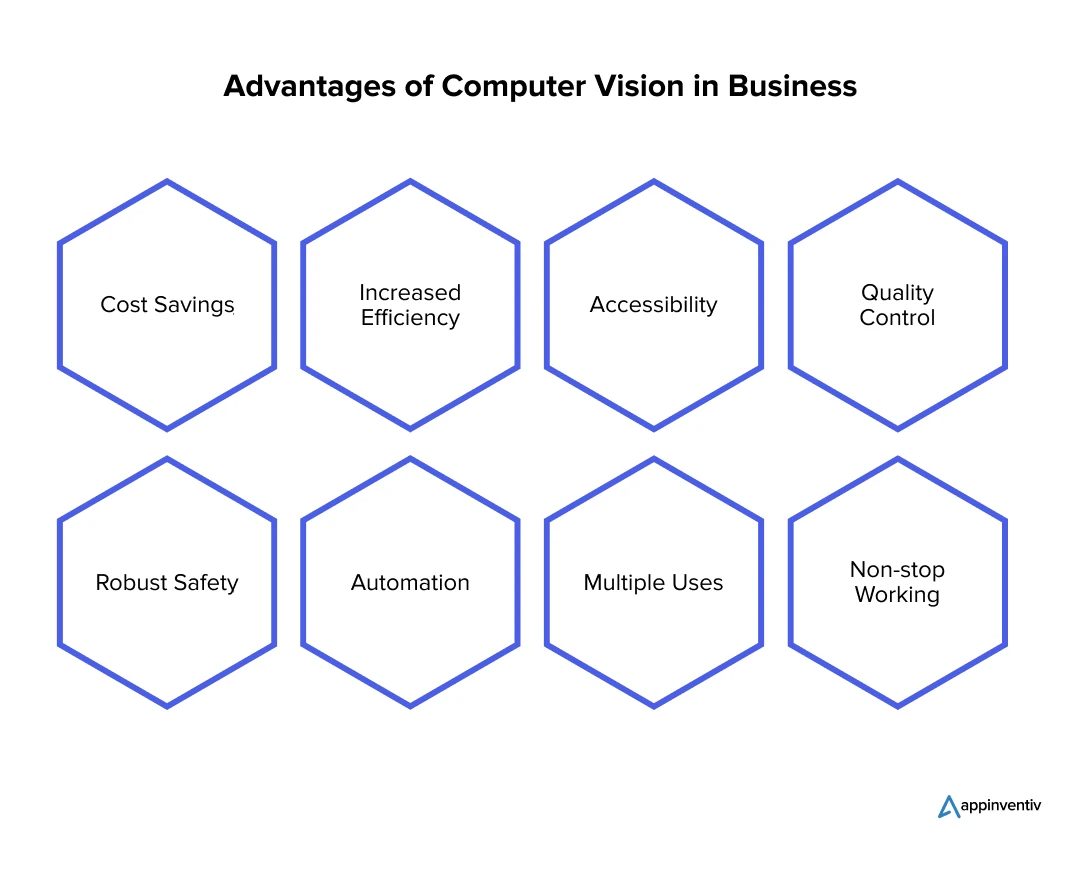
Cost Savings
Using computer vision for business can help you in cutting costs. This technology improves the efficiency of your business as you can automate several tasks using machine vision in AI. The result? Cost-effective operations without the need for manual intervention in the long run.
Increased Efficiency
Talking about the benefits of computer vision in business is incomplete without mentioning its ability to increase the efficiency of your company. Computer vision in AI is capable of handling large volumes of data without any error. This is similar to possessing a super-accurate data analyst for your company.
Accessibility
People with disabilities, for example, a visually impaired person can take the help of computer vision applications. The image recognition capabilities of machine vision in AI can assist such people by providing accessibility benefits.
[Also Read: Mobile Accessibility: How to Build an ADA and WCAG-Compliant Application?]
Quality Control
One of the other key advantages of computer vision is its ability to detect flaws in products. It can inspect your products and services and ensure you get flawless quality control that can scale up your business.
Robust Safety
You get improved safety by utilizing the components of computer vision in surveillance systems. The system can thus prevent crimes by identifying irregularities in your neighborhood.
[Also Read: How AI is Transforming Traditional Surveillance Systems]
Automation
Automation made possible by computer vision boosts productivity across a range of industries by decreasing the need for human intervention. Soon, we can imagine a production line where robots can inspect products without the need for human supervision.
Multiple Uses
Computer vision can be used for a wide range of activities. You can use the same system in different fields, such as logistics and supply chain management, warehouse tracking, etc. Another use of the same system can be found in the healthcare sector.
Non-stop Working
Since computer systems do not need any break, you can use computer vision 24/7. You don’t need to worry about human laborers taking breaks, as computer vision in AI can work nonstop. This system is the perfect choice for monitoring traffic and CCTV cameras.
Emerging Computer Vision Trends to Look Up to
Although computer vision applications in businesses are changing our environment today, the technology is still in its early stages of development. There is a lot of exciting work ahead in computer vision for business that could lead to revolutionary breakthroughs. These are probably the result of ongoing advances in machine learning and artificial intelligence, as well as the growing application of computer vision across a range of industries.
Here are a few computer vision trends that we can see in the future.
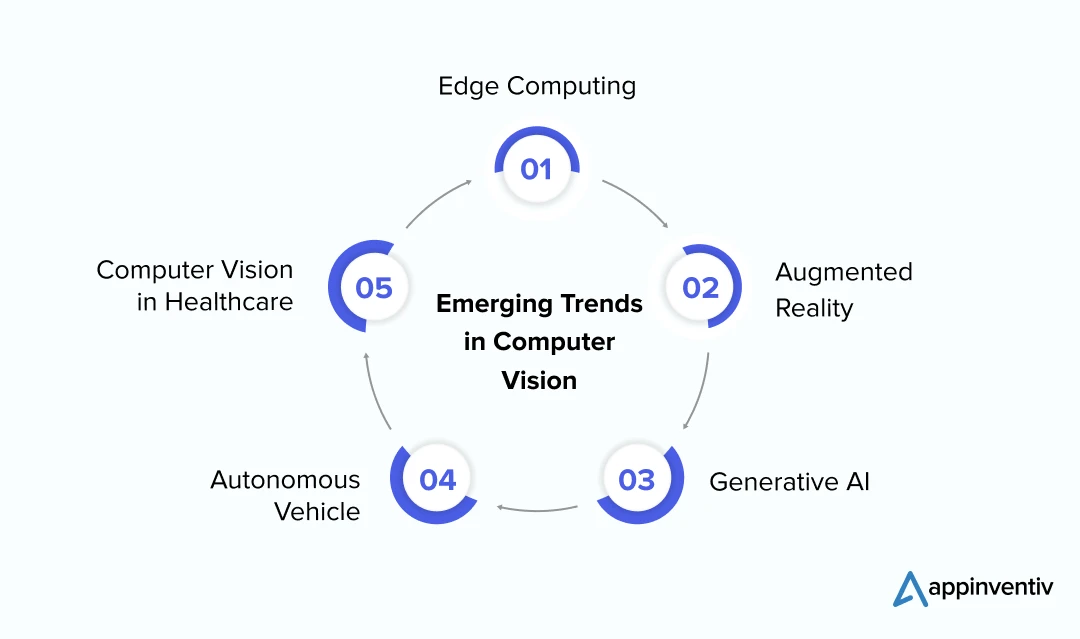
Edge Computing
In the field of computer vision in AI, edge computing is used to improve operations in real-time. When it comes to data privacy, edge computing becomes advantageous because it doesn’t require a data center. Courtesy of its proprietary architecture, it is more secure and harder for hackers to exploit. This ability to process data in almost real-time is beneficial for use cases of computer vision, ranging from intelligent security systems to driverless vehicles.
Augmented Reality
Augmented reality technology relies heavily on computer vision, which allows computers to interpret visual data and superimpose digital content on top of it. In 2024, a wave of brand-new consumer-grade AR products from brands like Apple and Meta might be released. This implies that technologies enhanced by computer vision will become more accessible. Augmented reality can enhance traditional teaching materials with captivating, immersive learning opportunities.
Generative AI
Due to the current surge in the popularity of generative AI systems, businesses all over the world are racing to investigate this technology’s revolutionary potential. Tools like Dall-E and ChatGPT from Open AI have helped to enhance operations and address issues that were previously unsolvable. With the help of generative AI services, combinations like text-to-image, text-to-video, and text-to-audio can be produced.
Autonomous Vehicle
One of the most important applications of computer vision in business in the future will be self-driving vehicles. These automobiles can identify things, recognize streets, and make judgments in real time to guarantee safe transportation, thanks to advanced vision systems that are outfitted with cameras and sensors. However, as these vehicles become more common, it won’t be long until the computers inside of them can operate almost solely on visual cues, just like a human driver.
Computer Vision in Healthcare
Computer vision in healthcare will have a significant impact on the sector, making health assessments more rapid and accurate. Doctors are better able to recognize and diagnose major illnesses, as well as to maintain timely and accurate records. In operating rooms, computer vision will also be used for several purposes, including monitoring surgical techniques.
Furthermore, augmented reality will be used more frequently by medical personnel to direct and even carry out remote surgery.
[Also Read: Machine Learning in Healthcare: Applications, Benefits, and the Future of Medical Innovation]
Navigating Challenges: Tackling Computer Vision Drawbacks for Businesses
While there are limitless computer vision benefits, ready to be leveraged across domains, this technology has a fair share of challenges as well. Take a look at some of the computer vision drawbacks for businesses.
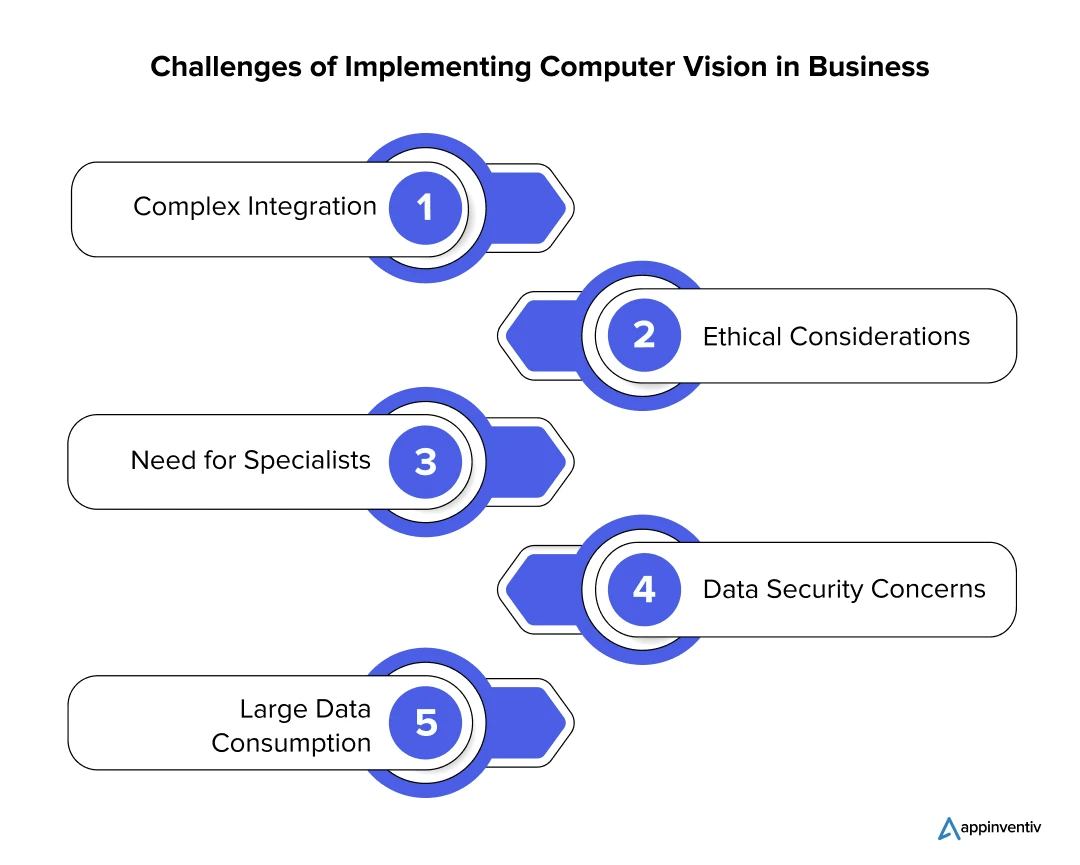
- Complex Integration:
Integrating the components of computer vision into your present business methods can be difficult and requires careful preparation. Resolving technological issues and ensuring seamless integration are essential components of an effective system.
- Ethical Considerations:
Before taking up computer vision for business, you should consider the ethical dimensions. It is important to pay close attention to the ethical aspects of computer vision, especially in fields like surveillance and facial recognition.
- Need for Specialists:
Experts in the field of computer vision in artificial intelligence are desperately needed. A professional who knows how the technology works can take full use of computer vision. Companies have to wait for such specialists as people are now learning the technical know-how.
- Data Security Concerns:
The abundance of images and videos available makes computer vision conceivable. There is a downside to this, as sensitive personal information may be accessed by public and commercial organizations. It is a significant social threat that needs to be discussed in public to protect citizens’ privacy and safety.
- Large Data Consumption:
Complex computer vision models cannot be used on older devices or by companies with tight budgets since they require expensive hardware to train and operate. Large amounts of processing power are needed to use neural networks to process vast volumes of data.
Employing Computer Vision With Appinventiv’s Expert Team to Empower Businesses
Now that we have covered the uses of computer vision, let’s talk about how Appinventiv can transform your business with our artificial intelligence services. Taking the help of an AI development company like ours for your business solutions can help you navigate the world of emerging technologies and avoid pitfalls.
We have an expert team of AI experts that ensure you reap the full benefits of computer vision in business. The expertise of our team is evident through our pool of successful AI projects, including Mudra, JobGet, Vyrb, and YouCOMM.
Reach out to us for successful implementation of computer vision solutions in business now!
FAQs
Q. How does computer vision work?
A. Computer vision in AI relies on identifying patterns in visual data like images and videos. Deep learning experts use this system to train computers how to behave like the human brain. It is a branch of AI that focuses on neural networks and machine learning.
Q. How is machine vision used in business?
A. If we talk about machine vision in businesses, its primary function in today’s world is to read labels and barcodes on products. Although commonly used in manufacturing plants, machine vision in AI can be used in any industry where you need accuracy to gauge and inspect products and services.
Q. What computer vision is used for?
A. The computer vision industry is a large sector covering the work of AI to learn the differences between visual objects. The applications of computer vision in business range from cancer detection and road monitoring to crop harvesting and preventive maintenance.
Q. How do companies use computer vision?
A. Computer vision for business helps a company to automate workflow, save costs, and increase efficiency. Various companies look forward to these computer vision benefits as AI is constantly evolving and changing the landscape of the business world.


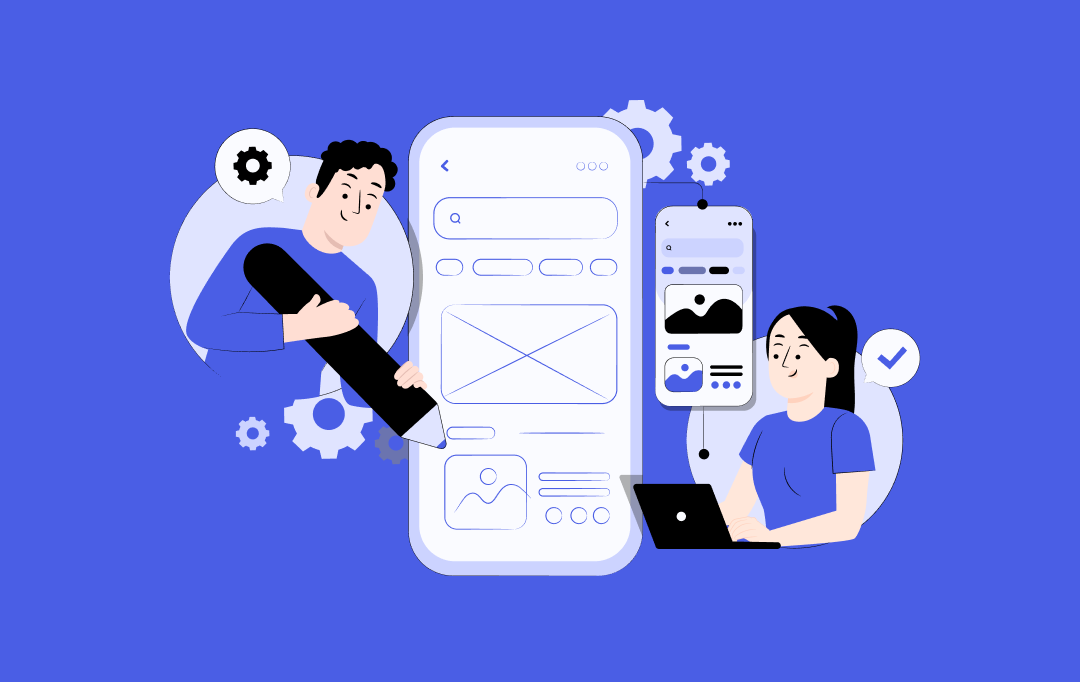
How Much Does It Cost to Build an App like Janitor AI?
Key takeaways: Cost Breakdown: The cost of app development varies, with an MVP App costing $40,000 to $90,000, a Mid-Tier App costing $100,000 to $200,000, and an Enterprise Grade App costing $300,000 to $ 500,000 or more, depending on features, complexity, and the expertise of the development team. Key Factors: Platform choice, AI integration, and…
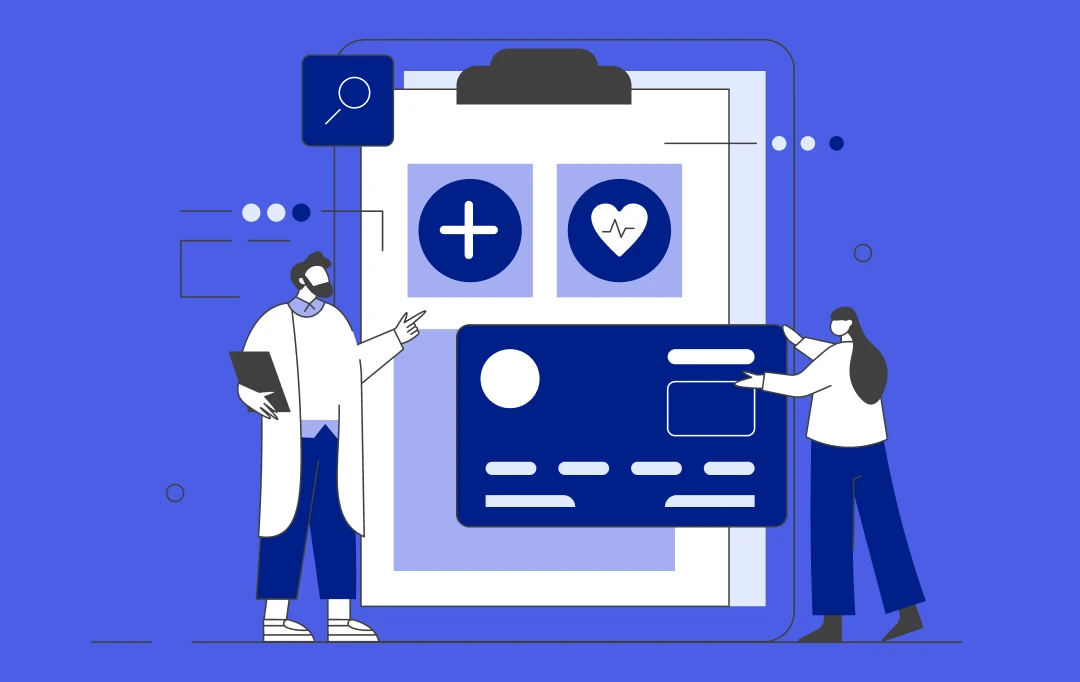
10 Ways AI is Transforming the Healthcare Sector in Australia
Key takeaways: Generative AI could add $13 billion annually to Australia’s healthcare sector by 2030. AI is already transforming operations across diagnostics, admin tasks, and patient care. Healthcare in remote areas is improving with AI-powered virtual assistants and monitoring tools. AI can help address workforce shortages by automating routine tasks and supporting clinical decisions. Major…
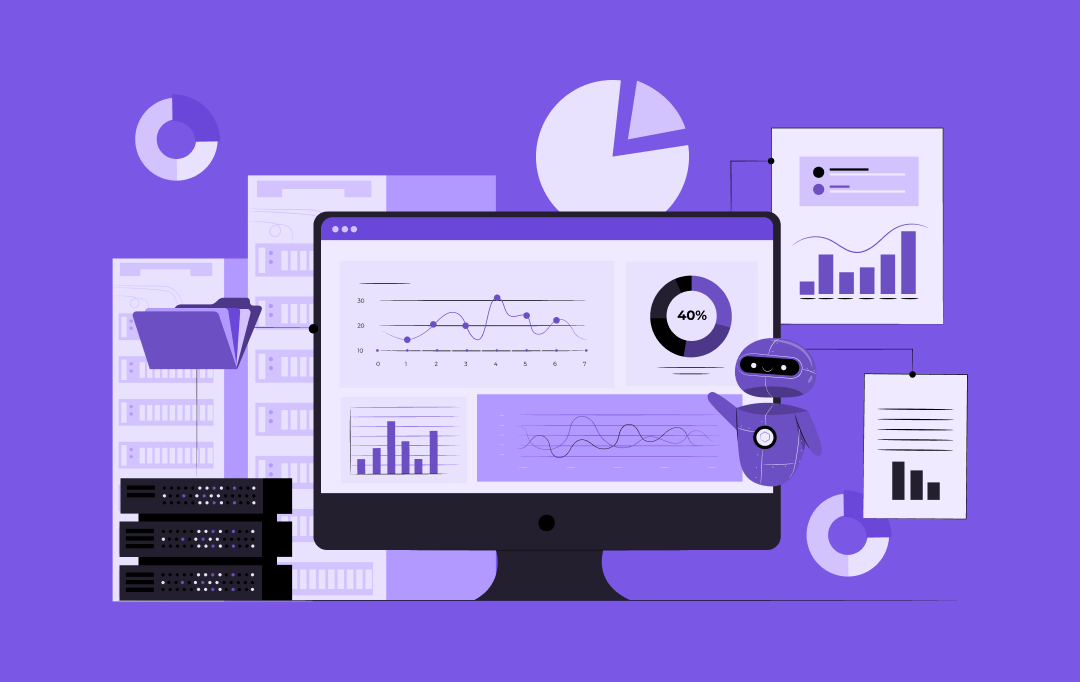
Exploring the Power of AI in Creating Dynamic & Interactive Data Visualizations
Key takeaways: AI transforms data visualization by providing automated insights, interactive dashboards, and NLP, thereby tackling revenue loss and improving data quality. Key features include predictive analytics, real-time data integration, and user-friendly visualizations, enabling faster and more informed decisions. Top 2025 tools, such as Tableau, Power BI, and Julius AI, offer NLP and real-time analytics…






